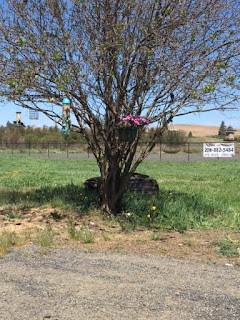why we were called the "Bombers"
I had a wonderful trip yesterday, amazing how much fun you can have in a day. Having alittle extra time , I drove around , a memory at every turn. As children we were allowed to walk just about anywhere in town, to the theater, the swimming pool, library, friends and of course school.Going down the street I grew up on it looked the same as it was when I left 36 yrs. ago. Still well kept, the only change was the people in the houses. So many of the homes I could tell you who lived in them....then. houses that I used to walk by on purpose hoping the boy I liked would see me, by best friends house, the drugstore we'd stop by on the way home from school for icecream, the "middle" sidewalk I walked to gradeschool on, my baton teachers house, I could go on and on.
When my mother was in High School they lived in New Jersey.( just think I could have been born on the east coast!) Her father was an engineer (as was his father)and worked for Dupont. He was transfered to Richland in 1945. My mother tells horror stories about the dust storms in this new town in the desert. The population is still 25,000 and a majority of the people work in the "areas". Both my brothers , my father, grandfather and grandmother worked there. I remember running to meet my father when he got off the bus around the block from us. The homes would be built in sections , there were A houses, B houses and on through Z. We lived in a ranch house , the last to be built. My manly man and I lived in an A house the year we were waiting to get into the FBI. Here's some interesting facts I found on the internet.................. they'll explain why we were called the "bombers" in High School.
Richland has a unique history. For many years Richland was a small farming village. In 1942 the federal government saw Richland's remote location, abundant water supply and mild weather as the right combination it needed for a portion of its Manhattan Project. Modern day Richland was born. Almost overnight the village of 247 people developed into a federally owned town of 11,000 residents. Thousands of workers from across the nation converged on the Hanford area to construct facilities where plutonium for the world's first nuclear weapons would be created.
The federal government contracted with DuPont to build nuclear reactors in the desert north of Richland. Eight reactors were built on the Hanford reservation. Plutonium from the Hanford reactors was used in the bomb dropped on Nagasaki, Japan which helped end the war. After the war General Electric took over the government contract for plutonium production that continued at Hanford.
Richland became a government town where Hanford scientists and workers lived. A security clearance was required to live in Richland. If a person lost their job they left town. There was no crime in the government-controlled town.
In 1958 Richland was incorporated as a chartered First-Class City governed by self-rule. As an independent city Richland continued to rely on the Hanford project. The city's population continued to climb as Hanford transitioned into weapons production during the Cold War years. In later years there were large population fluctuations based upon the Hanford work force build up or reductions. Many Richland residents are now employed at the Hanford site in its environmental cleanup mission.
The Hanford Project
The Pool we took swim lessons at every summer
Oh, my goodness these were the best donuts you've ever eaten and they were always
warm.
This was where we went for everything, prescriptions, birthday presents,
ice cream, licorice , and we usually went on our bikes doing errands for
our mom. It was only maybe a half mile from our house. Its still there and
is still called Densow's but it didn't look open.
(I'm pretty sure I wouldn't want this certificate)









The certificate is certainly strange. But, as it says, it did bring that part of the war to a 'successful conclusion'.
ReplyDeleteI love a trip down memory lane - and this was a good one. You're right - it's a very weird certificate, looking from the distance of over 60 years, but who knows where we'd be without the project it represents.
ReplyDeleteReally neat story! I loved your trip down memory lane! Sadly, I wouldn't want that certificate either, but as Cro said, it did bring bring a conclusion to the war and showed us that we'd never want anyone to use those bombbs again...
ReplyDelete